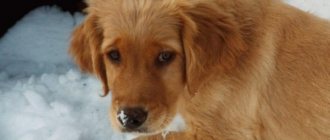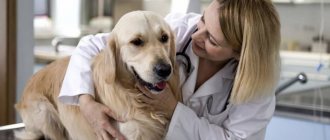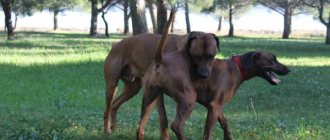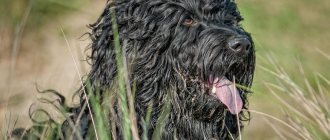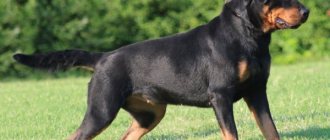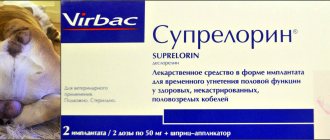The question of how to untie a male dog often arises both among novice dog breeders who decide to start breeding puppies, and among those who simply believe that their pet needs it. On the one hand, the concern of owners about their dog’s first mating looks somewhat strange. The animal intuitively knows what and how it should do, because in nature animals reproduce without human control. On the other hand, unsuccessful untying is quite capable of becoming the reason that the male will not be able to participate in breeding in the future. Therefore, it is extremely important for owners of highly purebred animals that their pet’s “first time” is successful.
What is knitting? Concept
Before untying a dog for the first time, especially a purebred dog that has value for breeding, you need to find out what exactly dog mating is and how it happens.
The definition of this process sounds simple enough. Mating, or mating, mating is a set of actions planned by a person, leading to the fertilization of the eggs of bitches with the seminal fluid of males under the control of the owners.
This is the difference between mating and the natural mating of animals, to which humans have nothing to do. Also, the mating of purebred dogs is legally accompanied, in fact being a business transaction. Animal owners enter into agreements that stipulate the obligations and rights of the parties, the material and financial aspects of the upcoming event.
What kind of mating can it be?
In the minds of most middle-aged people, those who had dogs in the pre-perestroika period, when in the country a purebred animal with a pedigree could be purchased only through membership in DOSAAF, matings can be unscheduled and official. In principle, a similar division applies to today.
From matings carried out outside the breeding plan of the canine society in which the dog is registered, puppies are born that do not have rights to pedigrees and other documents confirming their origin. Official or, as they more often say, planned matings are the mating of animals, after which puppies are born, registered by the club, receiving a pedigree and other documents.
Necessary documents for mating
At the time of mating, you must have a complete package of documents for two dogs (male and female).
These documents will be useful to you a little later (after 3.5 months), when you activate the puppies. Activation is an inspection of the litter by a third-party specialist (a representative of the kennel club), in order to assess the compliance of the puppies with the breed standard, their health status, culling and issuance of documents. Activation takes place when the puppies are 45 days old. So, the complete list of documents required to register a litter: 1. mating certificate () 2. copy of the bitch’s pedigree 3. copy of the bitch’s owner’s passport 4. original exhibition diploma with the bitch’s assessment or copies of championship titles 5. copy of the dog’s pedigree 6. copy of the owner’s passport male 7. original exhibition diploma with male evaluation or copies of championship titles 8. copy of kennel registration certificate (only for kennel owners)
How is mating understood in breeding work?
What is selection in simple words? This is a determination, the choice of the most suitable partner for an animal, allowing to obtain offspring with specific characteristics. In how to untie a stud dog that is valuable in breeding, this point is extremely important.
In breeding work, two types of matings are distinguished:
- inbreeding;
- cross
The term “inbreeding” refers to the mating of closely related animals. These matings make it possible to obtain offspring with impeccable characteristics that best meet the requirements of the breed standards.
Cross mating involves the mating of animals that do not have common ancestors in their pedigrees.
Both types of selective selection of a partner for a dog have both advantages and disadvantages, which, of course, relate not to the mating process, but to the offspring. Often, owners of stud dogs do not consider it necessary to delve into the nuances of breeding work, simply trusting the zoologist from the kennel club. Particularly often they do not pay attention to the type of choice of a partner in cases when the question of how to untie a male dog is being decided.
On the one hand, this position is somewhat justified, because the sale of puppies will be the responsibility of the owners of the bitch. But on the other hand, the offspring of a male dog is his reputation, a kind of “calling card”. Few owners of bitches would want to breed their pet with an animal that produces sick or severely defective puppies, even if he has collected all the titles in the world. Therefore, you need to be very careful when choosing a partner, starting from the very first time.
When choosing a male for breeding, you need to carefully consider the type of dog
Type is a visual characteristic that is not a defect, but, at the same time, has distinctive features from another dog of the same breed.
There are many types, therefore, try to select a male that will be visually similar to your female, so that the offspring, in the case of combining two types of genes, will not give rise to a third species that differs from the standards and does not fit the characteristics of the breed.
Also, when breeding a breed, it is necessary to take into account the dog’s temperament, which can be inherited as a not very good gift.
The dog's temperament should be taken into account if it manifests itself negatively. This is expressed by the dog entering into conflicts with other animals, disobeying the owner, uncontrolled behavior, and, possibly, aggression towards people.
When choosing a male dog for breeding, it is advisable not to select a dog with a temperament similar to a female dog, since in this case we risk getting a double dose of either an overly active temperament, or, conversely, a dog that is too passive.
Also, you should consider the purpose of breeding the puppy:
- — if we are breeding dogs that will subsequently participate in any competitions, then we should select a male with high energy and vigor;
- — if we breed domestic dogs, then we should not focus on the energy and activity of the male dog.
Do not forget about the possibility of breeding puppies according to their pedigree, therefore, you should take a closer look at males who are relatives of the bitch.
If the dog has a pedigree, then the puppies from this litter will be the most valuable, since the history of the ancestors plays an important role for future buyers.
Are there any peculiarities in the first mating?
Of course, the first time is special, for both people and dogs. However, these features are radically different. Animals do not need to create a romantic atmosphere, but the presence of an instructor will not hurt. Its functions can also be performed by the owner, but only if the person has practical experience in mating animals. In the case where there is no such experience, it makes sense to insist that the instructor not only carry out the mating, but train the owner. This will be useful in the future, because purebred dogs breed more than one or even a couple of females per year.
What is a person’s task during the first mating? It's about becoming part of the ritual. A dog should be calm about the fact that a person touches him, corrects him, helps him. As a rule, inexperienced dog breeders have a question about why this is needed. In how to untie a dog, human participation may not be required. But if the animal does not consider from the very first time that the person is part of the sexual contact, if any difficulties arise in the future, it simply will not allow its owners or instructors to approach it.
Of course, if we are talking about small dogs, then this is not a particularly important point. But if we are talking about mating representatives of large serious breeds, for example, mastiffs or shepherds, the habit of human participation is important.
For example, a bitch’s muscles will cramp while standing “in the castle.” Help will be needed to free the dog in the truest sense of the word. If a dog weighs over a hundred kilograms and has a fairly stern disposition, it will simply be impossible to approach it without shooting a dart with a sleeping pill. But if the dog immediately learns that the person is guiding him, is in contact - stroking him, pulling his ears, then the situation will be resolved differently and will not become stressful.
This means that in how to untie a male shepherd or other large breed, the participation of the owner and instructor is not only desirable, but also mandatory.
How to breed a bitch.
It is necessary to breed a bitch 1 or 2 times during the period of heat, and it is very important to correctly determine when to breed a bitch. You should not be 100% sure that you can breed any bitch to any male. There are many factors at work in this matter, including hierarchy. Some males who have a submissive tendency will not breed to a dominant female, even if they are champions, etc.
We suggest you read: Antiallergic drugs for cats
Sometimes a bitch can allow him to approach her, but at the last moment she will push him away. For reasons understandable only to them, dogs may not like each other. It very rarely happens that a bitch does not like it - the heat smells faint or occurs without maturation of the eggs, then the male is not interested (does not lick, does not groom).
Mating dogs becomes torture and real rape. Only experienced dog breeders from kennels who have carried out hundreds of matings can do this. Even in the case of such a mating, there is no guarantee of pregnancy. It happens that a male actively looks after a female, but does not mat. This means that the bitch is not mature, although she herself does not mind mating.
In such cases, the bitch comes to the male within 24 hours. It is necessary to avoid mating two inexperienced dogs. For the first mating of a female, an experienced and dominant male must be used. You need to untie a dog on an experienced bitch, who “stands rooted to the spot”... How to mate a bitch. Mating of dogs is preceded by a phase of courtship and play, the duration of which depends on the partners and their mood.
If the bitch is ready and eager to mate, and the male is experienced, the dogs agree in less than a minute. The male mounts the female and inserts the penis using a series of quick thrusts. This causes a reflex spasm in the bitch’s vagina, which holds the male’s penis until the act is completed – this is usually called a “lock”.
The ejaculate of a male dog consists of three different fractions - the initial secretion of the prostate gland, then a fraction rich in sperm, and then again a large volume of prostate secretion, which helps propel the sperm into the uterus. Owners who control the breeding of dogs must ensure that the dogs remain in the “ lock” (from 5 minutes to an hour).
The “lock” phase is very important, as it causes contractions of the bitch’s genitals, which promote the movement of sperm towards the uterus. When the dogs are in the lock and the male has turned around, the sperm release phase has ended, and when the lock is opened or not, the chances of pregnancy are reduced, but not equal to zero.
If the dogs are separated without a lock, the bitch should be held in a position with her hindquarters raised for about 10 minutes, and then not allowed to urinate or sit down for as long as possible. Often, especially during the first mating, the bitch may whine painfully or even howl - this is normal. Before mating, the dog should be treated with a solution of potassium permanganate in the area of the tail and genitals.
We suggest you read: Why does a cat eat poorly and sleep a lot?
The bitch should be wormed several days before her heat. A bitch is usually mated to a male dog (she does not allow him into her territory). To breed dogs you need to have: a good muzzle, a leather collar, a leash. The female Caucasian Shepherd often does not allow the male dog to approach her; in such cases, the dog must be tied or held.
In our kennel there are experienced breeding, dominant males for mating, champions of Russia, winners of many exhibitions, with certified working qualities - KS-1. We practice traveling with a male for mating dogs to the territory of the bitch. Zagorskie Dali Yuzhak is the most experienced male for mating, ready knit always and everywhere...
What exactly should the owner do at the first mating?
The answer to this question seems simple - to participate. But how exactly to do this? Often, animal owners who have no experience in breeding animals are as nervous before the upcoming event as if it were their own wedding. And this is precisely what cannot be done. The human's excitement is transmitted to the animal. And the dog’s psyche is structured in such a way that when it senses the owner’s nervous tension, the dog tunes in to protect him. Accordingly, he will be wary and aggressive towards the bitch, her owners and instructor.
The very actions that a person should carry out are extremely simple. When a male jumps onto a bitch, that is, makes a mount, you need to put your hand on his croup. There is no need to guide the animal unless there is a need for it. The point of the action is for the dog to get used to it and, if difficulties arise, not to be afraid or defend itself. Repeating this movement is required every time the male begins to mount. When dogs freeze in the castle, you need to pet the animal, pull behind the ears, but, of course, without effort. If other actions are required, the instructor leading the pairing will inform you about this.
Is it necessary to do this?
Despite the great similarity between the organisms of dogs and people, four-legged pets still differ from their owners. Nature intended that dogs, like many other animals, have sex very differently from humans. They do this solely for the sake of procreation, the appearance of offspring. Therefore, the “he wants it” arguments are wrong. A male dog will want it after he learns what a bitch in heat is and how to deal with her.
This means that after the first mating, others will be needed. When considering whether to untie a male dog, this is the first thing to think about. You should not rely on chance, that is, assume that a male, unlike a female, can satisfy his needs with any dog. Physiologically this is certainly true, but this “any” also needs to be found. Accordingly, you first need to study the demand for matings in your region.
Myth #1. Knitting for health.
I think that now women will understand me faster, but men are unlikely to dare to argue with me.
Do you think pregnancy and childbirth add health to a woman? Toxicosis? Varicose veins on the legs? Edema? What about breastfeeding? Mastitis? Hormonal imbalances? Sleepless nights? Nerves torn by experiences?... No, of course, nothing can compare with the joy of motherhood! But let's try to discard the “romance” and look at all this with an anatomical look, so to speak. No, pregnancy and childbirth are a big burden on the body, associated with deep hormonal changes. By the way, most doctors, precisely because of this very restructuring, advise women to give birth to a second child so that the body gets out of a state of stress and the hormonal levels return to normal.
So, a mother dog is, in essence, the same woman. And her body works according to the same principles as the body of any other female. With only one small digression that nature, unlike humans, intends for a dog to mate and give birth throughout its life, or not to give birth at all.
Therefore, if we knit a dog once, we thereby trigger the reproduction mechanism. That is, the same hormonal system of the bitch turns on, which after that, every heat, will release into the blood a fair share of the hormones responsible for fertilization, gestation, childbirth and feeding puppies.
And this, in turn, means that if there is no mating during the next heat or after the heat, this system will not stop working, but will only doze. And in any suitable case (perfeeding, reduction of usual loads, etc.) it results in false pregnancy, mastitis, and with age this is also an additional risk of pyometra.
When to do this?
The animal reaches sexual maturity at the age of 8-10 months. Theoretically, at the same age, the male is ready for mating. In practice, the first matings of animals take place after one and a half years. This is not due to physiology at all, but to practical considerations. In order to qualify for inclusion of a dog in the breeding plan, it is necessary to accumulate a certain number of awards and titles, and exterior data assessments. A couple of certificates for participating in exhibitions as a junior are not enough for this, so one-year-old males rarely end up untied.
If we put selection work aside, then at what age the male dog should be untied is up to his owners to decide. After reaching puberty, the dog is physiologically ready for mating.
Male age for breeding
A male dog reaches puberty at the age of eight months, but this does not mean that he is ready for mating. At this age, its physiology continues to develop: the formation of the skeleton, nervous and cardiovascular systems. January 21, 2013
A male dog reaches puberty at the age of 8 months, but this does not mean that he is ready for mating. At this age, its physiology continues to develop: the formation of the skeleton, nervous and cardiovascular systems. Untying too early is extremely harmful for a puppy that is not fully formed and can lead to the fact that a young male can “fall apart” - grow old ahead of time, and also lose the characteristic features of his breed.
Male hormones, in most puppies, begin to be produced at 6 months of age - at this moment sexual behavior appears (sometimes mating of bitches occurs). The testes enlarge and at 40 weeks of age the male dog is ready to ejaculate. At this time, his sexual maturity does not coincide with the ability to fertilize a female. A young puppy at this age has an insufficient concentration of sperm in the sperm, which do not have the required mobility. It is considered normal when a small amount of sperm is excreted in the urine before puberty. The quality of sperm increases until 14-18 months, after which puberty sets in, and mating with such a male will be complete.
Puberty in male dogs depends on the breed. As a rule, males of small breeds reach this age earlier than others. It is recommended to untie male dogs at the following ages:
- massive and large breeds (late maturation) at 2 years;
- medium breeds (medium maturation) from 15–18 months;
- small breeds (fast maturation) - 12 months.
Mating is given to a male dog if he has two testes, which in most puppies descend into the scrotum at the age of 10–40 days after birth. If this has not happened by 12 months of age, it can be assumed that undescended testes have occurred. If one testis is missing, the male should not participate in mating. Sometimes the testis (or both) is palpated in the abdominal cavity or closer, near the exit to the scrotum. The owner of the dog agrees on the operation. But the testis, as a rule, goes back after the operation. It must be remembered that any operation is almost always associated with risk and can end tragically. In addition, such a dog will still not participate in breeding work, due to the fact that he will carry the cryptorchidism genes. Mating with such a male is possible, but in this case it is advisable to completely abandon mating. In males who have never been mated, the sexual instinct fades away by the age of 5.5-6 years and they calm down.
For young males, the recommended number of matings on average is from 3 to 10 per year. It all depends on the breed, physical fitness and individual development. An early mated male (at 12 months) must be given time to mature (form). Otherwise, his health can be seriously undermined, and he may remain with signs of underdevelopment (infancy) for the rest of his life; he will simply become useless. The time for additional formation will depend on the breed and linear affiliation of each individual individual - on average it ranges from 6 months to 1 year. That is, it can be mated a second time at 14 months, and in the future it cannot be mated more than once a month until it reaches 18 months or 2 years.
There is an opinion among many dog lovers that the first (slightly premature) mating can stop the dog’s growth. To refute this, you need to understand the essence of the process: mating is a serious physical activity, sperm is released, and the dog experiences great emotional stress. But such states can be observed in the life of a young male dog even before his unleashing.
At the time of puberty, sperm begins to be produced constantly, but it tends to age quite quickly and lose its fertilizing ability. The body requires regular renewal of the supply of viable sperm. It can be released during wet dreams that are completely unrelated to sexual intercourse. In the process of unleashing, the degree of emotional tension is quite comparable to the emotions of a male during a fight, as well as at the moment of meeting with females in heat. It is not advisable to mate a young male before his puberty, but if this happens by accident, there is no need to be afraid - it may not affect the development of your dog in any way.
The first mating of a male dog should take place with an untied female dog who has sufficient mating experience. It is best for this to be a mature bitch who mates with desire and has a good (kind) character. She herself will “tell” her partner what to do and approve of him at the right time. For a beginning breeding male, a dog from the same kennel is best, or he needs to find a dog that he knows well. It is very important for the owner of the male to make sure that the bitch is currently ready for mating. Otherwise, she may scare him or even bite him.
- Like
- COMMENTS
- |
- leave a comment
- |
- Add to favorites 0
How often does an animal need to mate?
This is a fairly important question, for which there is no single answer. The fact that a male is untied does not mean that he can fertilize all the dogs in the area around the clock. The number of matings depends on many factors and, first of all, on the health of the dog.
As a rule, young animals, under three years of age, are bred 6-8 times a year. If the health of the animal and its exterior qualities allow a greater number of matings, then this, of course, is not prohibited. Males aged three to eight years are mated 20-30 times a year.
It is extremely important not to perform back-to-back matings, leaving at least a week between them. The dog needs to recover after mating, gain strength, and rest.
How to determine the first signs of readiness for mating?
For the first time, dogs must be mated under the supervision of their owners, since inexperienced dogs can accidentally harm each other. To obtain the maximum number of puppies, it is recommended to crossbreed during ovulation, which lasts from three to five days. This important time can be determined by the following signs:
- The vulva noticeably increases in size, swells, and becomes soft.
- The discharge takes on a characteristic yellow-pink hue. You can check this by using a clean cotton pad, which is passed over the vulva. It is advisable to do this immediately after sleep, since females carefully lick themselves while awake.
- The behavior of the female changes, she tries to attract the attention of the opposite sex.
- In company with male dogs, girls take a characteristic pose with their tail pulled to the side.
- After running your hand along the back, especially the hindquarters, the bitch assumes a ready position and draws back her tail.
In order to carry out the first mating of dogs on time, the owner of the bitch must keep a special diary in which he records all the individual signs of ovulation. Thus, some individuals begin to eat significantly more, while others, on the contrary, consume less food, but are more active during games and walks. Such specific signs will allow you to determine the best time for intimate dates as accurately as possible in the future.
Tips and recommendations from veterinarians for preparing an animal
If the owners have come to an affirmative answer to the question of whether it is worth untying a male dog, then it would not be a bad idea to learn about the preliminary preparation of the animal.
The main preparatory points are as follows:
- a full examination at a veterinary clinic and passing all the necessary tests no later than a month before mating;
- obtaining a health report;
- mandatory preventive treatment against skin and intestinal parasites 25 days before mating;
- if necessary, vaccination;
- feeding - 2-3 hours before mating, walking an hour.
If an invited instructor is involved in the process, the dog must be introduced to him in advance and given time to get used to this person.
Admission to mating and mandatory conditions
In order to register a mating with a canine organization and, accordingly, then receive documents (pedigrees) for the puppies, you need to fulfill a number of conditions.
If in the future, when you submit documents to the Russian Cynological Federation (RKF), at least some of these conditions are not met, you risk being left with puppies for which documents will not be issued. Firstly, age. At the time of mating, the female Chinese Crested dog must not be younger than 15 months, and the male must not be younger than 12 months. The extreme age also matters: the female must be no older than 7.5 years, for males there is no limit.
Bitches are allowed for breeding 6 times during the breeding period (read - during their life). Mating is allowed no more than once per calendar year. It is allowed to receive two litters in a row from one breeder, provided that the interval between births of litters is at least 6 months with a mandatory requirement for the breeder that the next litter from this breeder must be received no earlier than 365 days from the birth of the puppies of the last litter. Repetition of this periodicity is acceptable. But if you violate the specified intervals, then documents for the litter will not be issued.
Secondly, pedigree. At the time of mating, the male and female must have pedigrees of the Russian Canine Federation. Not the puppy cards that were given to you when you bought the puppy, but the pedigree cards - those light laminated pieces of paper. If the mating is very soon, and you don’t have the documents yet, then you can submit your puppy card to the RKF for an urgent pedigree (done within one day).
Thirdly, the assessment from the exhibition. Both dogs (male and female) must have a show grade (the so-called “breeding grade”). The assessment must be obtained before mating at the official RKF certificate show. For males this rating is not lower than “excellent”, for females - not lower than “very good”. Dog owners submit the original diploma to the RKF once when registering the first litter of their dogs.
